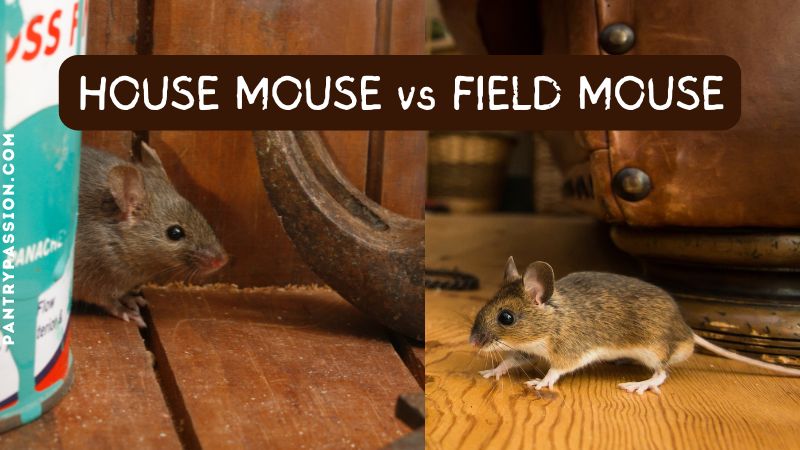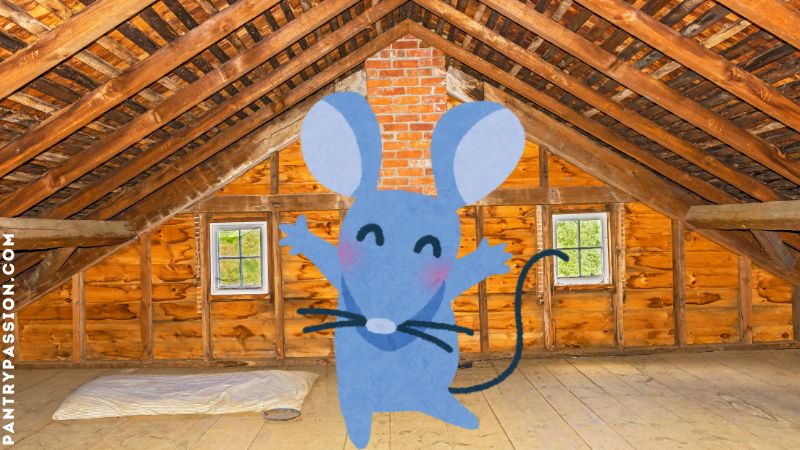The Best Fluffy Pancakes recipe you will fall in love with. Full of tips and tricks to help you make the best pancakes.
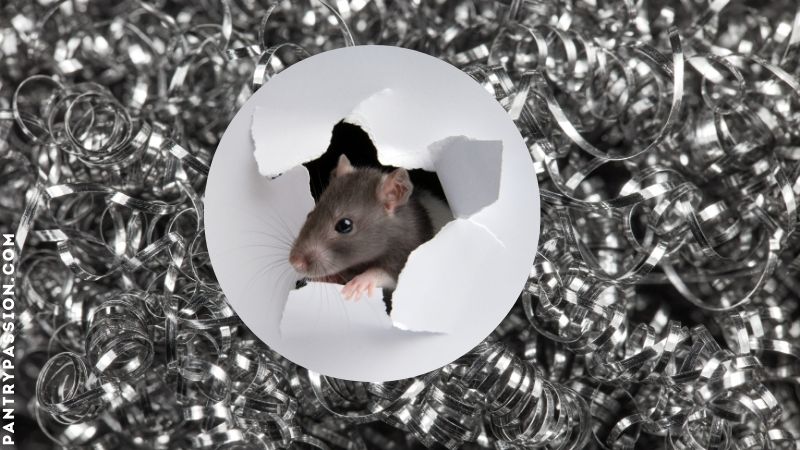
Mice. These tiny invaders are more than just a nuisance — they can contaminate food, damage property, and spread disease. The good news? You can fight back with smart, effective mouse-proofing strategies. If you’re wanting to know how to mouse-proof, we’ve got you covered.
We’ve compiled the most comprehensive list of materials, products, and strategies to help you seal every crack, block every entry point, and outsmart even the craftiest critters. From steel wool, using the right products to protect your stuff, to clever hacks and long-term prevention tactics, this post arms you with everything you need to reclaim your space—the right way.
Let’s get your home fortified and mouse-free, once and for all.
DON’T MISS Pantry Passion’s Complete Article List for Mouse & Rat Prevention!
Table of Contents
- What Can Mice and Rats Chew Threw?
- Protect Your Stuff With Metal Mouse-Proof Storage
- Steel Wool for Mouse Proofing — Quick Reference Table
- Copper Mesh & Copper Wool for Mouse-Proofing
- Hardware Cloth: Mouse-Proofing Secret Weapon
- Galvanized Steel & Mesh: A Superior Rat-Stopping Product
- Which is Best for Mouse-Proofing: Expanding Foam or Silicone Caulk?
- Locating Mouse Entry Points
- BONUS: Mouse-Proofing Chart for Home & Outdoor Environment
What Can Mice and Rats Chew Threw?
First, let’s establish what mice can chew through, which is just about anything. This will put you in the right frame of mind to take mouse-proofing seriously. If you don’t know already, rodent’s teeth never stop growing, thus the need for constant gnawing (plus eating your yummy food and animal feed!).
Here are common materials that mice and rats can chew through:
- PVC pipes
- anything plastic, especially plastic made from soy and soy-based insulation on wiring harnesses
- plastic-coated wires
- PEX pipe
- wood
- cardboard
- fibers/clothing
- drywall, sheetrock
- ceiling tiles
- air bricks, also known as ventilation bricks or air vents
- cinderblock
- aluminum steel wool
- uncured cement
- low gauge aluminum (even rain gutters!)
Your best material to block mice is going to be metals such as copper, steel, steel wool, hardware cloth and hard materials such as brick, cement and glass. Read on as I go into the benefits of each one for mouse-proofing.
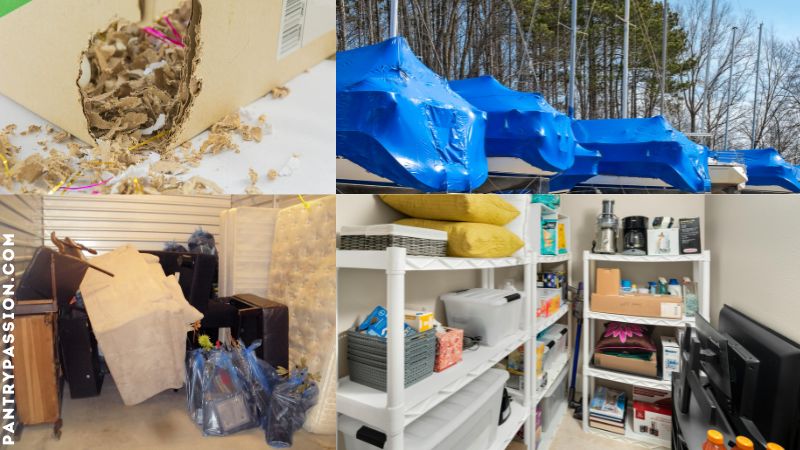
Protect Your Stuff With Metal Mouse-Proof Storage
From cars to garages to farms, selecting the right mouse-proof storage is the key to protecting your stuff.
Metal is always the best:
- Metal trash can
- Rodent-proof bird seed containers
- Ammo boxes sold at military surplus store
- Footlockers aka army trunk sold at military surplus store
- Galvanized rectangular horse feed containers
- Bear cans or bear canisters
- Jobsite boxes
- Tool box
- Metal filing cabinet (without gaps, can get cheap used ones)
- Non-working chest freezers
- Steel drum, metal barrels – get clamp style closure and rubber gasket.
- Shipping container
Can Mice Chew Through Plastic?
Metal is king, but thick plastic can slow mice down. Will rats and mice chew through a plastic peanut butter jar? Easily – especially with the incentive of food inside. Good quality plastic, such as Rubbermaid bins or food grade buckets will work for food and general storage of items in your garage.
Tuff Stuff Products FS12 HD Feed/Seed Storage 12 Gallon 12GALLON is a plastic bucket with a locking lid. Vault Pet Food Storage is another particularly helpful plastic bin (promoted as keeping racoons out, although there are a few break-ins of very determined racoons!).
Some people even go one step further with plastic and stuff steel wool around lid and seal with duct tape. In out buildings/sheds where it would be impossible to keep mice and rats out, I would stay with metal mouse-proof containers.
Steel Wool for Mouse Proofing — Quick Reference Table
Steel wool is a popular way to seal mouse entry points: it’s easier to work with because it’s flexible. Steel wool is even more effective when combining with expansion foam. Many people use the combo to seal off holes from the outside around pipes and wires.
However, there are instances where you should avoid using steel wool. Refer to this chart for guidance:
| Category | Details | Notes / Examples |
|---|---|---|
| Why Use Steel Wool | Flexible and easy to work with for sealing small mouse entry points. | Works well when packed tightly into gaps. Ideal for gaps 1″ or smaller. |
| What Type to Use | – High tensile strength steel wool. – Grade #3 or #4 (very coarse to extra coarse). – Stainless steel preferred (won’t break down like regular steel wool). | Avoid cheap, soft dish scrubbies — too gentle, rodents can remove them. Look for brands marketed for rodent control. |
| When NOT to Use Steel Wool | Fire risk: Steel wool is flammable, especially fine grades (easily sparks fire as seen in this Youtube video). Avoid if mouse-proofing ovens or areas with sparks. Rust risk: Not ideal for exterior use; deteriorates when wet. Galvanic corrosion: Avoid contact with copper piping. | Coarse steel wool is safer for mouse-proofing but still risky in high‑heat or moisture-prone areas. FYI, the finer steel wool leaves “filament dust” which creates a mess. Requires periodic inspection and replacement. |
| Alternatives | Xcluder Rodent Control Stainless Steel: Stainless steel + poly fiber, rust-proof, non-flammable. – Excluder Doubled: Industrial-strength silicone sealant with embedded sharp fibers. – Hardware cloth (screwed in). – Metal flashing. – Tin cans. | Xcluder and Excluder products create permanent seals and resist gnawing. Hardware cloth and flashing are durable for exterior use. |
Copper Mesh & Copper Wool for Mouse-Proofing
Copper wool or copper mesh is not considered flammable under normal conditions. Unlike steel wool, which can ignite when exposed to a flame due to its fine strands and iron content, copper has a much higher ignition temperature—around 1,984°F (1,085°C)—making it very resistant to catching fire. Just like steel wool, it is ideal for mouse entry points 1″ or smaller.
However, there are a few important caveats:
- 🔥 Finely divided copper, such as copper powder or dust, can be flammable or even explosive when dispersed in air and exposed to a spark or flame. This is due to the increased surface area and reactivity.
- ⚗️ Chemical reactions: Copper can react with strong acids (like nitric acid) to release hydrogen gas, which is highly flammable. But this is more of a lab hazard than a household concern.
If you’re using copper wool for cleaning (like the popular Chore Boy copper scrubbers), pest control, or DIY projects, it’s generally safe and not a fire risk. Just avoid grinding it into powder or exposing it to extreme chemical conditions.
Can Mice Chew Through Copper Pipes?
It was difficult to find any expert to comment on if mice could chew through copper pipes (which is softer than steel), but an article on Bug King mentioned copper as a material that mice could chew through. Since Bug King is a pest control company, I figured they have personally witnessed mouse and rats chewing through copper pipes.
Pestex Company lays it out, the teeth of a rodent are 5.5 hardness on the Mohs Scale. Several Internet sources indicate a copper penny is a hardness of 3.5. It appears that copper doesn’t have a chance against a gnawing mouse if determined.
Alan’s Factory Outlet displays an infographic of The Hardness of Metals. To give you and idea:
- 100 Mohs: Carbon
- 4.0 Mohs: Steel
- 3.0 Mohs: Copper & Brass
- 2.75 Mohs: Aluminum
- 1.5 Mohs: Lead
Rodents have the upper hand here, but it is not completely hopeless. Combining mouse-proofing techniques encourages them to move on to easier targets.
Hardware Cloth: Mouse-Proofing Secret Weapon
Hardware cloth is a strong, welded wire mesh made from galvanized steel or stainless steel, often coated with PVC for added durability. It’s commonly used in construction, gardening, and pest control due to its rigid structure and resistance to rust and chewing.
For rodent control, ¼” mesh with 19–23 gauge wire is highly effective because mice can’t squeeze through or chew it easily. You can also purchase 1/8″ hardware cloth, perfect for filling in around pipes, cracks, and seams.
According to TWP:
“Rodent-control wire mesh can be applied to air vents, soffit screens, floor drains, foundation vents, gutters, fan guards, chimneys, and exposed pipes throughout your house. The material can also be installed under your porch and throughout your yard and garden to keep critters at bay.”
Hardware cloth is also effective at keeping other pests out, including snakes, birds, gophers, raccoons, squirrels, chipmunks, and bats.
Key Features of Hardware Cloth
- Material: Usually galvanized steel; some versions are PVC-coated for weather resistance
- Mesh Size: Ranges from ¼” to ½” openings, ideal for keeping out small animals like mice, rats, and snakes
- Gauge: Thicker wires (lower gauge numbers like 19 or 23) offer more strength
- Applications:
- Rodent-proofing homes and gardens
- Reinforcing vents, soffits, and crawl spaces
- Building animal enclosures or chicken coops
- Supporting plants or compost containment
Can Rats Chew Through Hardware Cloth?
In reality, a mouse or rat can chew through hardware cloth with enough time and determination. Basically, hardware cloth slows them down – way down. As one homesteader put it, “Yes [rats can chew through hardware cloth], but they won’t have enough teeth left to eat your chickens by the time they get through.”
If you’re worried that the hardware cloth is very easy to cut with a scissors, you may have purchased a lower-grade of wire.
Hardware Cloth VS Chicken Wire: Side-by-Side Comparison
While chicken wire and hardware cloth might look similar at a glance, they serve different purposes and have distinct characteristics. Here’s a breakdown:
| Feature | Chicken Wire | Hardware Cloth |
|---|---|---|
| Material | Thin, galvanized steel wire | Thicker galvanized or stainless steel wire |
| Pattern | Twisted into a hexagonal mesh | Woven or welded into a square/rectangular grid |
| Gauge | 20–22 gauge (very thin) | Heavier gauge, stronger and more rigid |
| Mesh Size | Large openings, often up to 2″ | Small openings, often 1″ or less |
| Flexibility / Strength | Very flexible, easy to shape; prone to sagging, warping, and tearing | Much more durable, resistant to bending or breaking |
| Primary Uses | Containing chickens, lightweight garden fencing | Predator‑proofing coops, securing gardens, industrial applications |
| Protection Level | Minimal — won’t stop determined predators | Excellent — blocks raccoons, snakes, mice, rats, mice, and other intruders |
| Durability | Shorter lifespan; may need frequent replacement | Long‑lasting, withstands weather and impact |
| Cost | Cheaper upfront | More expensive, but cost‑effective long‑term |
Galvanized Steel & Mesh: A Superior Rat-Stopping Product
Many homeowners opt for galvanized stainless steel wire mesh for DIY exclusion of rats, mice, and other pesky rodents. Galvanize means to to coat (metal, especially iron or steel) with zinc.
To galvanize steel, it’s dipped into molten zinc or treated with electrolytic reactions. This forms a stable, protective zinc coating, which makes the product extremely resilient.
Galvanized hardware cloth is budget-friendly, durable, resistant to water, high heat, freezing temperatures, corrosion, and rust. It lasts for up to two decades, which is longer than plain steel wire mesh.
According to the U.S. National Park Service, galvanized metal screens are the best material for excluding mice and rats:
“It [galvanized hardware cloth] is both rust and corrosion resistant and
available in different gauges (diameter of the wire mesh) and different mesh or grid sizes (number of openings per square inch) for various needs. For mice exclusion use the ¼ “, 16-19 gauge hardware cloth; rats can be excluded using the ½” hardware cloth, however, it is recommended to install the ¼” for both animals to prevent potential mice entry.”
Compared to steel wool that does rust, galvanized wire and steel does not rust.
In some cases, rats will chew through wood, cinder block, mortar, plastic, and even aluminum. That’s why the protective zinc coating of galvanized hardware cloth is so vital when rodent-proofing your home.
Which is Best for Mouse-Proofing: Expanding Foam or Silicone Caulk?
Make sure the mouse or mice are gone before you seal any holes. As they could still be inside your home. Or they’ll just make another hole and get in.
For mouse-proofing, neither silicone caulk nor standard expanding foam alone is ideal—but each has its place when used strategically. Here’s how they stack up:
Expanding Foam to Fill Mouse Holes
- Pros:
- Fills large gaps (a couple inches wide) and irregular spaces easily (fills in areas that silicone can’t reach)
- Creates an airtight and water-resistant seal.
- Some products (like DAP Mouse Shield or Tomcat Rodent Block or Great Stuff Pest Block) are specially formulated to resist gnawing and include pest deterrents.
- Cons:
- Standard foam (not pest-rated) is easily chewed through by mice.
- Can degrade over time if exposed to moisture or UV light.
- Not suitable for small or precise gaps.
- Hard to clean up, especially off of skin.
- Limited shelf life once open.
Silicone Caulk to Block Mouse Cracks
- Pros:
- Flexible and durable; great for sealing small cracks and joints.
- Adheres well to most surfaces and handles temperature changes.
- Less prone to shrinking or cracking over time.
- Cons:
- Mice can chew through it if used alone.
- Doesn’t fill large gaps or voids effectively.
PRO TIP: Use high quality exterior silicone caulking/sealant. The caulking will expand and contract with the changing temperatures, where expanding foam will not.
A Multi-Layer Defense is Best for Mouse-Proofing
The most effective approach is layered defense:
- Stuff gaps with copper or steel wool, 1/8” galvanized steel mesh, or both (mice hate chewing through metal and it’s especially helpful around pipes and wires).
- Seal over with expanding foam (preferably pest-resistant).
- Use silicone caulk for finishing touches around edges or in tight spots.
This combo makes it physically difficult and unpleasant for mice to chew through, while also sealing off airflow that attracts them. One mouse-fighting veteran predicted that using silicone + steel wool together should last 30 years.
Tips From the Pros: Add These Ingredients to Caulk or Foam
Expanding foam is not mouse-proof on its own. Users report that the “pest blocker” foam isn’t very effectove, it simply has a “bad tasting” additive in the foam. For a rock-solid rat and mouse defense, add these materials to silicone or foam:
- crushed glass
- mouse/rat poison
- crushed red pepper (review my list of the spiciest mouse deterrents)
USER TIP: Fill aluminum foil envelope with powdered crushed red pepper inside, crunch it, and fill the hole.
Locating Mouse Entry Points
It’s the nooks and crannies, folks! Mice typically enter a home through the foundation: cracks, spaces around pipe/HVAC systems, or chewing their way in through wood. Don’t forget the weak spots around windows and doors.
Thawing and freezing can move some elements of the home, or cause rotting – points where mice can get in. Also look under stairs, porches, and basement windows that can be hidden points we don’t often check.
Professional pest control persons have a trained eye where mice can potentially enter a home. It’s imperative to address the current infestation before plugging mouse holes. Once under control, walk around the exterior of your home and find any openings ¼ inch or larger and seal them up. As one person described it, “mice ‘pancake’ their body to get in.”
Do the same inside of your home. Kitchen base cabinets are easy access, with gaps that are perfect for mice.
It sounds daunting – that’s why professionals are recommended, and they warranty their work for a year (at least the good ones do).
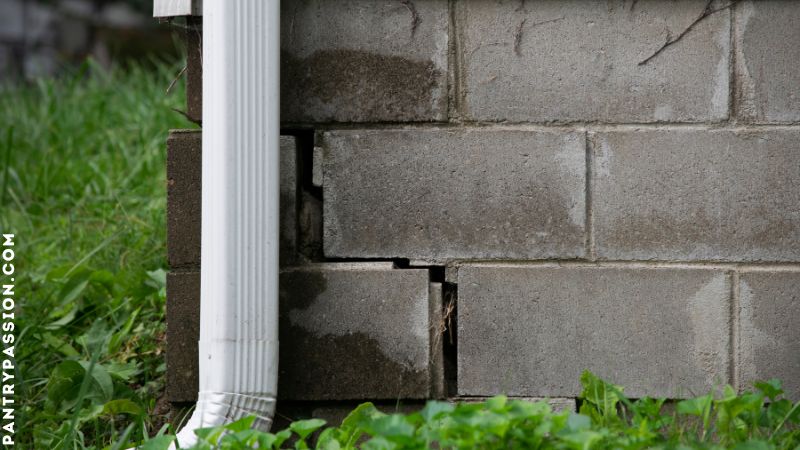
Things to look for:
- holes around ductwork, electrical outlets, AC, and pipe fittings coming into building
- basement foundation openings
- under door spaces like pantry and garage
- points where a garage attaches to a house
- brick and soffit intersections
- attic door that mice can get in from the roof
- holes in drywall that mice have chewed through
- examine fireplaces that have chimney access from the roof
- check dryer vents and floor vents and air vents
TIP: Downspouts are easy ways into your roof and possibly attic. Consider mesh expanding downspout covers. Push one in all the way at the downspout near the ground so it expands and fills the opening. You can also install them at the opening at the roof gutter.
You won’t be able to examine everywhere; mice climb and their entry point could be on the second story. Keep landscaping away from the foundation and trimmed well, mice love cover – predators can get them out in the open so they avoid it.
Look for the signs of mouse and rat activity: “rub” or grease marks left by oily/greasy fur and scratching and chew marks and feces/rodent droppings. Both rats and mice are incontinent – this means they are constantly dribbling urine. This creates a trail of activity that can be seen with special lights.
Use Mirrors & Lights To Find Mouse Gaps
If you’re not finding mouse gaps, you need to take your snooping up to the next level!
Go inside the storage unit or garage, close all doors and turn off any lights. If you can see ANY sunshine peaking thru, secure it with strong steel wool. Get some type of mirror on a stick (like what dentist use) and walk around the outside bottom edge of the container and make sure there is no separation from the foundation of the unit that they can climb up.
Use the same techniques to inspect under RV carriages, vehicles, etc.
How Small of a Hole Can a Mouse Get Through?
When it comes to how big of a hole or small of a hole a mouse can get through, you’re going to hear references to “dime-sized holes” “no bigger than your pinky finger” or “the size of a pen.”
You probably want real size measurements. Luckily, Shawn Woods of Youtube mousetrap fame did an experiment to figure this out, setting up a segmented box of drilled holes of various sizes in plexiglass. He then scattered food in each slot to see which holes the mice could enter. The results were clear. The mice could get into the 5/8 inch hole (which is smaller than a dime) and up.
But a round hole is different than a gap. Mice can flatten their bodies to get through them. Shawn re-engineered his experiment and switched from holes to gaps, and then placed his experiment in a known mouse area and baited it with food and a motion camera.
It wasn’t long before the mice came, entering the biggest (easiest) gap first. As mice emptied food in each slot, they attempted to enter the smaller openings.
Basically, the mouse struggled in 13 mm gap, unable to make it through (slightly larger than a 1/2 inch gap). The 14 mm gap was no problem. As Shawn says “when mouse-proofing a house, you need to fill in every thin gap – they [the mice] can squeeze through a tight space even more than a hole.”
The mouse in the experiment were your average size mice. Baby mice – that’s a different story so beware! As one mouse-control expert put it, “If they can get their head in, they can get their whole body in.”
BONUS: Mouse-Proofing Chart for Home & Outdoor Environment
Mouse-proofing isn’t just about traps and poison — it’s about prevention. By sealing entry points, storing food properly, and maintaining cleanliness, you can make your home a fortress against furry intruders.
Are you using the wrong type of peppermint oil? Check out Pantry Passion’s Guide to Peppermint Oil: Winning the Battle Against Mice.
Here’s your quick checklist:
| Area | Mouse-Proofing Must-Haves |
|---|---|
| Pantry | Airtight containers, door sweep, steel wool. |
| Kitchen | Trash can with lid, clean spills, peppermint oil. |
| Garage | Declutter, seal cracks, use mouse-proof garage storage bins (ideally, metal) Inspect walls and ceilings inside and out regularly for chew marks or gaps. Use traps or repellents: Place near walls and entry points. |
| Garage Door Seal | Choose a rubber or vinyl seal that fits snugly (the best is Xcluder X2 Rodent Proof Overhead Sectional Door Seal). Add a metal threshold plate for extra protection. |
| RV/Mobile Home | Inspect undercarriage: Seal gaps with expanding foam or mesh. Vent covers, floor register mesh, rodent-proof skirting, inspect plumbing & electrical access. Place monitoring stations (sticky traps) against the each side of any entrance just in case. Store food in airtight food containers: Even in the off-season. se dryer sheets or peppermint oil: Place in drawers and cabinets. |
| Dog Door | Use motion-activated lights near the door. Install a magnetic or electronic dog door that only opens for your pet/Seal gaps around the frame with weather stripping that contains steel mesh. |
| Pet Food | Metal bins, elevated feeders, sealed containers, locked bins. |
| Car Storage | Rodent-proof cover, peppermint sachets, traps. (refer to my ULTIMATE LIST of mouse-proofing vehicles using natural mouse repellent ideas). |
| Patio/Pool/Deck | Keep gear in sealed deck box (hard plastic or metal box with a locking lid), elevate the box off the ground if possible, leave lids up and store cushions somewhere else in the winter. |
| Outdoor Trash Cans | Use metal trash cans or buy special trash can locks. |
| Grill/BBQ | Follow these steps to Mouse-Proof Grill |
| Mouse-proof vent covers/air vents | Use metal mesh screens behind vent covers. Avoid plastic — mice chew through it. Seal edges with caulk or weather stripping. |
| Mouse-Proof Dryer Vent Cover | Install a louvered vent cover with a flap that closes when not in use. Add a wire mesh screen inside the duct; Use mouse-proof vent covers made of metal mesh. Clean lint regularly — buildup attracts nesting mice. If covering vents, make sure they aren’t dryer vents – that’s illegal due to fire code. |
| Mouse-Proof Floor Registers | Remove register covers and install hardware cloth underneath. Reattach covers securely. Check for gaps around the duct opening and seal with foam. |
With a little effort and the right tools, you can reclaim your home and every other corner of your outside — from unwanted guests.



